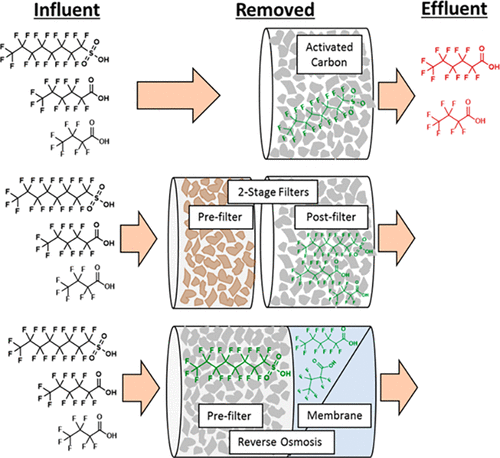当前位置:
X-MOL 学术
›
Environ. Sci. Technol. Lett.
›
论文详情
Our official English website, www.x-mol.net, welcomes your
feedback! (Note: you will need to create a separate account there.)
Assessing the Effectiveness of Point-of-Use Residential Drinking Water Filters for Perfluoroalkyl Substances (PFASs)
Environmental Science & Technology Letters ( IF 8.9 ) Pub Date : 2020-02-05 , DOI: 10.1021/acs.estlett.0c00004 Nicholas J. Herkert 1 , John Merrill 2 , Cara Peters 1 , David Bollinger 1 , Sharon Zhang 1 , Kate Hoffman 1 , P. Lee Ferguson 1 , Detlef R. U. Knappe 2 , Heather M. Stapleton 1
Environmental Science & Technology Letters ( IF 8.9 ) Pub Date : 2020-02-05 , DOI: 10.1021/acs.estlett.0c00004 Nicholas J. Herkert 1 , John Merrill 2 , Cara Peters 1 , David Bollinger 1 , Sharon Zhang 1 , Kate Hoffman 1 , P. Lee Ferguson 1 , Detlef R. U. Knappe 2 , Heather M. Stapleton 1
Affiliation

|
Per- and polyfluoroalkyl substances (PFASs) have come under increased scrutiny due to concerns about their potential toxicity and prevalence in the environment, particularly drinking water. PFASs are difficult to remove in full-scale water treatment systems because of their physicochemical properties. Here we evaluated the effectiveness of point-of-use (POU) and point-of-entry (POE) residential drinking water filters in removing a suite of three perfluoroalkyl sulfonic acids, seven perfluoroalkyl carboxylic acids, and six per- and polyfluoroalkyl ether acids in homes in central (n = 61) and southeastern (n = 12) North Carolina. POU systems included countertop and pitcher filters, faucet-mounted filters, activated carbon block refrigerator filters, activated carbon block under-sink filters, under-sink dual-stage filters, and under-sink reverse osmosis filters. All under-sink dual-stage and reverse osmosis filters tested showed near complete removal for all PFASs evaluated. In contrast, all other filters containing activated carbon exhibited variable PFAS removal. In these filters, PFAS removal efficiency was dependent on chain length, with long-chain PFASs (∼60–70% removal) being more efficiently removed than short-chain PFASs (∼40% removal). A few whole-house activated carbon POE systems (n = 8) were also evaluated; however, results were variable, and in some cases (four of eight systems), increased PFAS levels were observed in the filtered water.
中文翻译:

评估使用点的家用饮用水过滤器对全氟烷基物质(PFAS)的有效性
由于对全氟烷基物质和多氟烷基物质(PFAS)的潜在毒性和在环境中(特别是饮用水)的普遍性的担忧,因此受到越来越多的审查。PFAS由于其理化特性,在全尺寸水处理系统中很难去除。在这里,我们评估了使用点(POU)和进入点(POE)居民饮用水过滤器在去除一组三种全氟烷基磺酸,七种全氟烷基羧酸以及六种全氟烷基醚酸和多氟烷基醚酸中的有效性。在中部(n = 61)和东南部(n= 12)北卡罗来纳州。POU系统包括台面和水罐过滤器,水龙头安装式过滤器,活性炭块制冷机过滤器,活性炭块下沉式过滤器,下沉双级过滤器和下沉反渗透过滤器。对所评估的所有PFAS进行的所有下沉式双级和反渗透过滤器均已接近完全去除。相反,所有其他包含活性炭的过滤器均表现出可变的PFAS去除率。在这些过滤器中,PFAS的去除效率取决于链长,长链PFAS(约60-70%的去除率)比短链PFAS(约40%的去除率)更有效。一些全屋活性炭POE系统(n= 8)也进行了评估;但是,结果是可变的,并且在某些情况下(八个系统中的四个),在过滤后的水中观察到PFAS含量增加。
更新日期:2020-02-06
中文翻译:

评估使用点的家用饮用水过滤器对全氟烷基物质(PFAS)的有效性
由于对全氟烷基物质和多氟烷基物质(PFAS)的潜在毒性和在环境中(特别是饮用水)的普遍性的担忧,因此受到越来越多的审查。PFAS由于其理化特性,在全尺寸水处理系统中很难去除。在这里,我们评估了使用点(POU)和进入点(POE)居民饮用水过滤器在去除一组三种全氟烷基磺酸,七种全氟烷基羧酸以及六种全氟烷基醚酸和多氟烷基醚酸中的有效性。在中部(n = 61)和东南部(n= 12)北卡罗来纳州。POU系统包括台面和水罐过滤器,水龙头安装式过滤器,活性炭块制冷机过滤器,活性炭块下沉式过滤器,下沉双级过滤器和下沉反渗透过滤器。对所评估的所有PFAS进行的所有下沉式双级和反渗透过滤器均已接近完全去除。相反,所有其他包含活性炭的过滤器均表现出可变的PFAS去除率。在这些过滤器中,PFAS的去除效率取决于链长,长链PFAS(约60-70%的去除率)比短链PFAS(约40%的去除率)更有效。一些全屋活性炭POE系统(n= 8)也进行了评估;但是,结果是可变的,并且在某些情况下(八个系统中的四个),在过滤后的水中观察到PFAS含量增加。











































 京公网安备 11010802027423号
京公网安备 11010802027423号